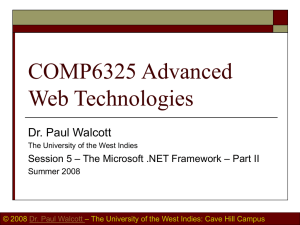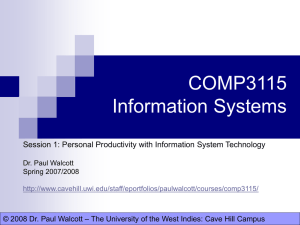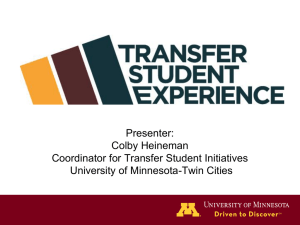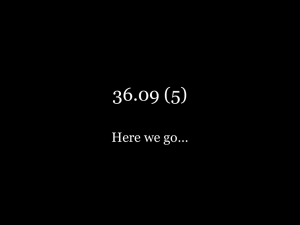Information Systems Theory and Practice
advertisement
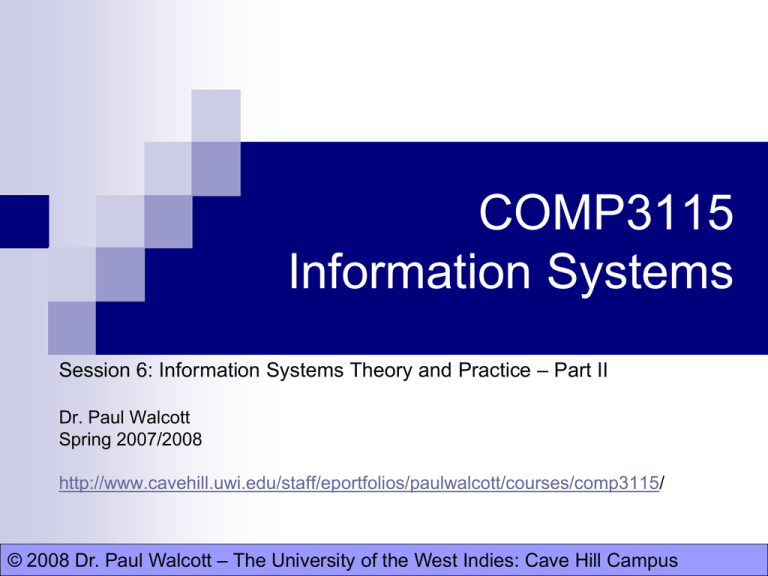
COMP3115 Information Systems Session 6: Information Systems Theory and Practice – Part II Dr. Paul Walcott Spring 2007/2008 http://www.cavehill.uwi.edu/staff/eportfolios/paulwalcott/courses/comp3115/ © 2008 Dr. Paul Walcott – The University of the West Indies: Cave Hill Campus Session Objectives Comprehend the characteristics of an organisation Comprehend the societal and ethical issues relating to Information Systems Compare and Contrast IS and organisational systems © 2008 Dr. Paul Walcott – The University of the West Indies: Cave Hill Campus Introduction In the last session we looked at, among other things: System theory and concepts For example the work system model © 2008 Dr. Paul Walcott – The University of the West Indies: Cave Hill Campus Ethical and Societal Issues (O’Brien and Marakas, 2006) Many ethical responsibilities emerge when dealing with information technology (IT) Questions such as the following might be asked: Is IT being used in a way that is harmful, improper or irresponsible to individuals or the society? What are the proper business uses of computers and the Internet? © 2008 Dr. Paul Walcott – The University of the West Indies: Cave Hill Campus Ethical and Societal Issues (O’Brien and Marakas, 2006) The introduction of IT provides both benefits and detrimental effects: For example, an automated car manufacturing plant, produces higher quality cars, however workers lose they jobs as a result © 2008 Dr. Paul Walcott – The University of the West Indies: Cave Hill Campus A business professional or manager therefore needs to minimise detriments and maximise benefits © 2008 Dr. Paul Walcott – The University of the West Indies: Cave Hill Campus Ethical Foundations Business Ethics There are a number of ethical questions that managers must answers. The some of the areas of controversy are: Intellectual property rights Customer and employee privacy Security of company records Workplace safety © 2008 Dr. Paul Walcott – The University of the West Indies: Cave Hill Campus Ethical Foundations Cont’d There are two theories of corporate responsibility that should be considered: Stockholder theory Social contract theory © 2008 Dr. Paul Walcott – The University of the West Indies: Cave Hill Campus Stockholder theory states that ”managers are agents of the stockholders, and their only ethical responsibility is to increase the profits of the business without violating the law or engaging in fraudulent practices.” (O’Brien and Marakas, 2006) © 2008 Dr. Paul Walcott – The University of the West Indies: Cave Hill Campus Ethical Foundations Cont’d It is therefore the ethical responsibility of the firm to ensure that it is managed in a way that benefits the stakeholders (including employees and suppliers) © 2008 Dr. Paul Walcott – The University of the West Indies: Cave Hill Campus Social contract theory states that “companies have ethical responsibilities to all members of society, which allows corporations to exist based on social contracts.” (O’Brien and Marakas, 2006) © 2008 Dr. Paul Walcott – The University of the West Indies: Cave Hill Campus Ethical Foundations Cont’d The social contract theory is based on two conditions: 1. The economic satisfaction of consumers and employees must be enhanced “without polluting the environment or depleting natural resources, misusing political power, or subjecting their employees to dehumanizing working conditions (O’Brien and Marakas, 2006).” © 2008 Dr. Paul Walcott – The University of the West Indies: Cave Hill Campus Ethical Foundations Cont’d 2. Fraudulent practices must be avoided; employees must be respected as human beings; and practices may not be employed which negatively impacts any group or society. © 2008 Dr. Paul Walcott – The University of the West Indies: Cave Hill Campus Ethical Foundations Cont’d Technology ethics needs to be considered when using any form of IT For example, employers of data entry clerks should provide regular work breaks to avoid health issues: hand injuries and CRT exposure There are four guiding principles: Proportionality Informed consent Justice Minimised risk © 2008 Dr. Paul Walcott – The University of the West Indies: Cave Hill Campus Ethical Foundations Cont’d Proportionality The benefits provided by the technology should be greater than the risks More importantly, if there is a less harmful alternative then this should be selected Informed consent The risks should be understood and accepted by affected individuals © 2008 Dr. Paul Walcott – The University of the West Indies: Cave Hill Campus Ethical Foundations Cont’d Justice Risks should be shared by all who benefit; the risks of those who do not benefit should not significantly increase Minimised risk Unnecessary risks should be avoided © 2008 Dr. Paul Walcott – The University of the West Indies: Cave Hill Campus Ethical Guidelines Some companies employ ethical guidelines from professional bodies One such set of guidelines are the ATTP Standards of Professional Conduct (O’Brien and Marakas, 2006, pp. 438) © 2008 Dr. Paul Walcott – The University of the West Indies: Cave Hill Campus Other Social, Legal, Ethical and Economic Implications Patterson (2005) provides a useful discussion of these implications See pp.109-133. Required reading. http://www.ltscotland.org.uk/resources/images /usinginformationint2h_tcm4-221261.pdf Included in this discussion are: Social implications such as the ease of access of Information systems and privacy © 2008 Dr. Paul Walcott – The University of the West Indies: Cave Hill Campus Other Social, Legal, Ethical and Economic Implications Cont’d Legal implications Data Protection Act Computer Misuse Act, and so on. Note some of these Acts have been enacted in Barbados http://www.commerce.gov.bb/Legislation/default.asp Economic implications Jobs – training costs, and so on. © 2008 Dr. Paul Walcott – The University of the West Indies: Cave Hill Campus IS and Organisational Systems In Session 1, we discussed various types of information systems We will be expanding that discussion in this session This discussion with be based on Section 2 of Patterson (2005) © 2008 Dr. Paul Walcott – The University of the West Indies: Cave Hill Campus IS and Organisational Systems Cont’d The different types of information systems fall within the following organisation levels: Organisational level Users of IS Type of IS Strategic CEOs and Directors Executive Tactical Middle management - Decision Support Systems - Management IS Operational Low level management and workers Data Processing Systems © 2008 Dr. Paul Walcott – The University of the West Indies: Cave Hill Campus IS and Organisational Systems Cont’d Data Processing Systems (DPS) These systems are also refered to as transaction processing systems because they deal with daily transactions These systems were first developed in the 1940s and 1950s Replaced manual clerical procedures © 2008 Dr. Paul Walcott – The University of the West Indies: Cave Hill Campus IS and Organisational Systems Cont’d Data Processing Systems (DPS) The IT requirements of these systems can be as simple as a desktop computer Or may be a mini or mainframe computer with dumb terminals © 2008 Dr. Paul Walcott – The University of the West Indies: Cave Hill Campus IS and Organisational Systems Cont’d Management Information Systems (MIS) A MIS converts internal and external data into information which is transmitted to and used by managers who make decisions or create plans “MIS produce reports for managers interested in historic trends on a weekly, monthly or yearly basis (Patterson, 2005).” The information in these reports provide answers to routine questions, for example week sales reports © 2008 Dr. Paul Walcott – The University of the West Indies: Cave Hill Campus IS and Organisational Systems Cont’d Management Information Systems (MIS) These systems do not employ complicated mathematical models, rather summaries and comparisons © 2008 Dr. Paul Walcott – The University of the West Indies: Cave Hill Campus IS and Organisational Systems Cont’d Decision Support Systems (DSS) These systems “provide information and models in a form to help tactical and strategic decision making (Patterson, 2005).” DSS are useful for adhoc decision making © 2008 Dr. Paul Walcott – The University of the West Indies: Cave Hill Campus IS and Organisational Systems Cont’d Decision Support Systems (DSS) These systems integrate company data; business rules, analytical tools and models; and a simple user interface Managers use these systems to make a decision based on a set of alternatives © 2008 Dr. Paul Walcott – The University of the West Indies: Cave Hill Campus IS and Organisational Systems Cont’d Executive Information Systems (EIS) Senior managers use these systems to make strategic and tactical decisions These systems track, filter and compress data; and analyse and compare information to determine trends Use graphic visualisations to help interpret the data EIS utilise data from: External events (for example new tax laws) Internal events, for example MIS and DSS systems © 2008 Dr. Paul Walcott – The University of the West Indies: Cave Hill Campus IS and Organisational Systems Cont’d Expert Systems Utilise knowledge of human experts to draw inferences It comprises of a knowledge base, inference engine and a user interface © 2008 Dr. Paul Walcott – The University of the West Indies: Cave Hill Campus IS and Organisational Systems Cont’d Expert Systems The knowledge base stores facts, rules and information The inference engine “interprets the rules and facts using backwards and forward chaining to find solutions to user queries.” The user interface allows users to enter knowledge and query the system © 2008 Dr. Paul Walcott – The University of the West Indies: Cave Hill Campus IS and Organisational Systems Cont’d Expert Systems These systems are used in organisations to capture knowledge Provide expertise at any time (since humans are not always available) Generate solutions to complicated problems © 2008 Dr. Paul Walcott – The University of the West Indies: Cave Hill Campus Organisational Management Systems Concepts Four useful concepts: Speed of processing computers; processor and storage device speed Accuracy. How accurate is the information Volume. The number transactions the system can handle Efficiency is a combination of speed, accuracy and volume of data processed number of accurate transactions per minute © 2008 Dr. Paul Walcott – The University of the West Indies: Cave Hill Campus Role of IT and People Using IS “The interaction between information technology and organizations is very complex and is influenced by a great many mediating factors, including the organization’s structure, standard operating procedures, politics, culture, surrounding environment and management decisions.” (Laudon and Laudon, 2005) © 2008 Dr. Paul Walcott – The University of the West Indies: Cave Hill Campus Role of IT and People Using IS Cont’d Before implementing an IS in an organisation, the nature of the organisation must be understood So what is an organisation? © 2008 Dr. Paul Walcott – The University of the West Indies: Cave Hill Campus “An organisation is a stable, formal social structure that takes resources from the environment and processes them to produce outputs.” (Laudon and Laudon, 2005) © 2008 Dr. Paul Walcott – The University of the West Indies: Cave Hill Campus Role of IT and People Using IS Cont’d In an organisation: Capital and labour are provided by the environment The organisation produces products and services The products and services are consumed by the environment in exchange for more inputs © 2008 Dr. Paul Walcott – The University of the West Indies: Cave Hill Campus Role of IT and People Using IS Cont’d Since an organisation is a legal entity it is more stable than a group of people formed for a given purpose © 2008 Dr. Paul Walcott – The University of the West Indies: Cave Hill Campus The behavioural definition of an organisation is “a collection of rights, privileges, obligations and responsibilities that are delicately balanced over a period of time through conflict and conflict resolution.” (Laudon and Laudon, 2005) © 2008 Dr. Paul Walcott – The University of the West Indies: Cave Hill Campus Role of IT and People Using IS Cont’d People in organisations therefore: Develop ways of working Determine how work will be done © 2008 Dr. Paul Walcott – The University of the West Indies: Cave Hill Campus Role of IT and People Using IS Cont’d These definitions of organisations imply that the introduction of a new information system is not merely a technical exercise Rather, it will affect the rights, privileges, obligations and responsibilities of individuals This undoubtedly will affect the balance of the organisation © 2008 Dr. Paul Walcott – The University of the West Indies: Cave Hill Campus Role of IT and People Using IS Cont’d According to Weber (cited in Laudon and Laudon, 2005), orgainsations are bureaucratic in nature Most efficient form of an organsation © 2008 Dr. Paul Walcott – The University of the West Indies: Cave Hill Campus Role of IT and People Using IS Cont’d Organisations therefore typically have the following structure: Clear division of labour and specialisations Employees are organised in a hierarchy where everyone reports to someone else A set of rules (standard operating procedures) governs all actions © 2008 Dr. Paul Walcott – The University of the West Indies: Cave Hill Campus Role of IT and People Using IS Cont’d Decision making therefore should be impartial since they are based on a set of predefined rules Employees are hired based on their skills and competencies rather than based on who they know The efficiency of an organisation is maximised Maximising output using limited input © 2008 Dr. Paul Walcott – The University of the West Indies: Cave Hill Campus Role of IT and People Using IS Cont’d Standard operating procedures (SOP), which are developed over time, describe: Organisation rules, practices and procedures SOP result from operational efficiency Business processes are developed from SOP Changing SOP is difficult and may require production to be stopped temporarily © 2008 Dr. Paul Walcott – The University of the West Indies: Cave Hill Campus Role of IT and People Using IS Cont’d Two additional factors that affect the introduction of information systems that change goals, people, procedures and productivity are: Organisational politics Organisational culture © 2008 Dr. Paul Walcott – The University of the West Indies: Cave Hill Campus Role of IT and People Using IS Cont’d Organisational Politics People in organisations are different These difference often “result in political struggle, competition, and conflict within every organisation (Laudon and Laudon, 2005).” This political opposition may prevent an IS from being introduced, or being used effectively © 2008 Dr. Paul Walcott – The University of the West Indies: Cave Hill Campus Role of IT and People Using IS Cont’d Organisational Cultural “… is this set of fundamental assumptions about what products the organization should produce, how it should produce them, where, and for whom (Laudon and Laudon, 2005).” This is a unifying force Promotes understanding and agreement Resistance will result if an IS threatens to change the culture © 2008 Dr. Paul Walcott – The University of the West Indies: Cave Hill Campus Role of IT and People Using IS Cont’d Some of the unique features of an organisation include: The type of organisation e.g entrepreneurial versus professional bureaucracy (knowledge-based organisation; goods & services depend on expertise and knowledge of professionals; dominated by department heads) A law firm of school system is an example © 2008 Dr. Paul Walcott – The University of the West Indies: Cave Hill Campus Role of IT and People Using IS Cont’d Unique features of an organisation include: Environment resources are drawn and product and services are sold in this environment; organisations must adapt to their environment quickly Goals Leadership Technology used Business processes © 2008 Dr. Paul Walcott – The University of the West Indies: Cave Hill Campus Role of IT and People Using IS Cont’d Organisations must make decisions about the “technical and organisational configuration of systems (Laudon and Laudon, 2005).” Also, they must decide who will build and maintain the IS © 2008 Dr. Paul Walcott – The University of the West Indies: Cave Hill Campus “The formal organizational unit or function responsible for technology services is called the information systems department;” and is responsible for the hardware, software, networks and data of the organisation. (Laudon and Laudon, 2005) © 2008 Dr. Paul Walcott – The University of the West Indies: Cave Hill Campus Role of IT and People Using IS Cont’d The Information systems department comprises of: Programmers Systems analysts IS managers External specialist, e.g. security The information systems department may be headed by the chief information officer © 2008 Dr. Paul Walcott – The University of the West Indies: Cave Hill Campus Role of IT and People Using IS Cont’d The function of each of these roles should be very familiar to the reader since these roles were discussed at length in the software engineering course © 2008 Dr. Paul Walcott – The University of the West Indies: Cave Hill Campus Conclusion In this session: Ethical theories, responsibilities and guidelines were discussed Different types of information systems described, and The structure of an organisation analysed © 2008 Dr. Paul Walcott – The University of the West Indies: Cave Hill Campus References Laudon, Kenneth, C., Jane, P. Laudon. 2005. Essentials of Management Information Systems: Management the Digital Firm. 6th Edition. Upper Saddle River, New Jersey: Prentice Hall O’Brien, James, A., George, M., Marakas. 2006. Management Information Systems. 7th Edition. New York: McGraw-Hill. Patterson, Alan. 2005. Information Systems: Using Information. Learning + Teaching Scotland. Available online at http://www.ltscotland.org.uk/resources/images/usinginformationint2h_tcm4221261.pdf © 2008 Dr. Paul Walcott – The University of the West Indies: Cave Hill Campus
